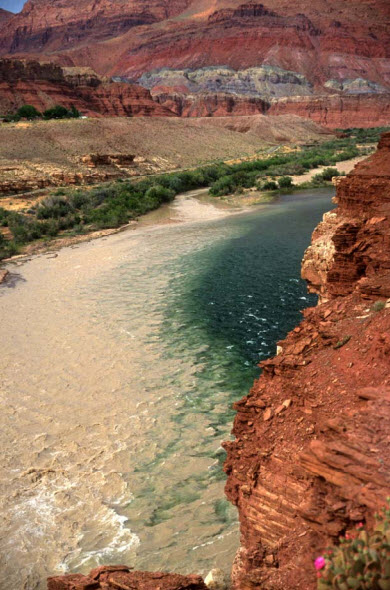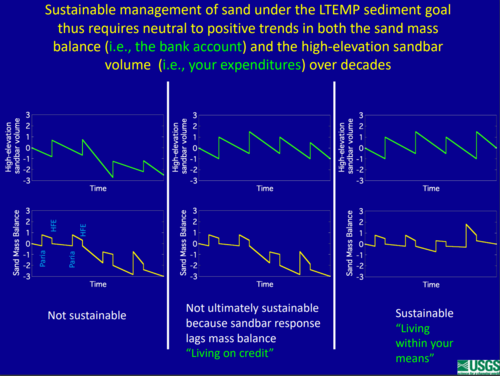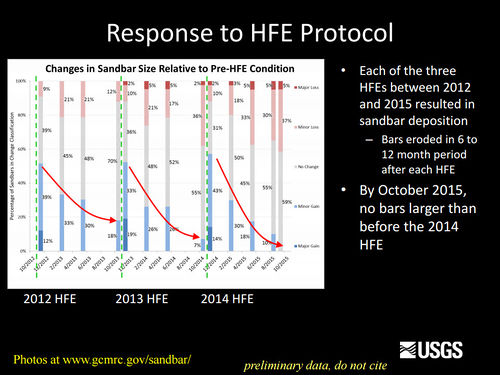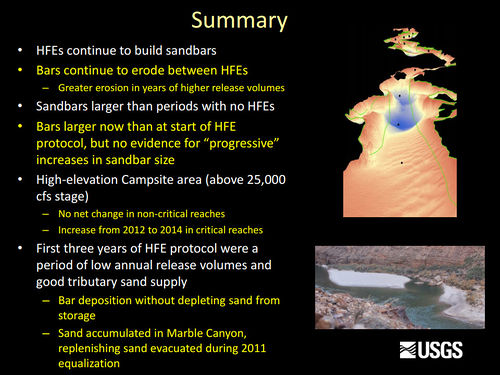Difference between revisions of "GCDAMP Sediment"
Cellsworth (Talk | contribs) |
Cellsworth (Talk | contribs) |
||
| (21 intermediate revisions by the same user not shown) | |||
| Line 58: | Line 58: | ||
|- | |- | ||
|style="color:#000;"| | |style="color:#000;"| | ||
| + | |||
| + | [[File:SedimentSustainability.PNG|center|thumbnail|500px|https://www.usbr.gov/uc/progact/amp/twg/2022-01-13-twg-meeting/20220113-AnnualReportingMeeting-ProjectA-StreamflowWaterQualitySedimentTransportBudgetingColoradoRiverEcosystem-508-UCRO.pdf ]] | ||
| + | |||
| + | [[File:LongtermDecline.PNG|center|thumbnail|500px|https://www.usbr.gov/uc/progact/amp/twg/2022-01-13-twg-meeting/20220113-AnnualReportingMeeting-ProjectA-StreamflowWaterQualitySedimentTransportBudgetingColoradoRiverEcosystem-508-UCRO.pdf ]] | ||
[[File:SandbarMonitoring2016.jpg|center|thumbnail|500px|[https://www.usbr.gov/uc/rm/amp/twg/mtgs/17jan26/AR3_Grams.pdf https://www.usbr.gov/uc/rm/amp/twg/mtgs/17jan26/AR3_Grams.pdf] ]] | [[File:SandbarMonitoring2016.jpg|center|thumbnail|500px|[https://www.usbr.gov/uc/rm/amp/twg/mtgs/17jan26/AR3_Grams.pdf https://www.usbr.gov/uc/rm/amp/twg/mtgs/17jan26/AR3_Grams.pdf] ]] | ||
| Line 96: | Line 100: | ||
|style="color:#000;"| | |style="color:#000;"| | ||
| + | *[http://gcdamp.com/index.php?title=Portal:GCDAMP_Knowlege_Assessments GCMRC Annual Reports page] | ||
*[https://www.gcmrc.gov/sandbar/ GCMRC Grand Canyon Sandbar Monitoring] | *[https://www.gcmrc.gov/sandbar/ GCMRC Grand Canyon Sandbar Monitoring] | ||
*[http://gcdamp.com/index.php?title=The_HFE_Page The High Flow Experiment (HFE) Page] | *[http://gcdamp.com/index.php?title=The_HFE_Page The High Flow Experiment (HFE) Page] | ||
| Line 101: | Line 106: | ||
*[[Aeolian Sand Transport| Aeolian Sand Transport Page]] | *[[Aeolian Sand Transport| Aeolian Sand Transport Page]] | ||
*[http://gcdamp.com/index.php?title=Turbidity Turbidity Page] | *[http://gcdamp.com/index.php?title=Turbidity Turbidity Page] | ||
| + | *[http://gcdamp.com/index.php?title=GCDAMP-_Over-Flights Over Flights Page] | ||
|- | |- | ||
| Line 158: | Line 164: | ||
|- | |- | ||
|style="color:#000;"| | |style="color:#000;"| | ||
| + | |||
| + | '''2024''' | ||
| + | *[[Media:Sartain_AGU2023_poster_ARM.pdf| Assessing geomorphic change for 454 river km of the Colorado River in Grand Canyon, AZ via continuous and high-resolution water surface and bed profiles | ||
| + | ]] | ||
| + | *[[Media:Kaplinski_Glen_canyon_flow_model_poster_20240114.pdf| Hydrodynamic modeling of the Colorado River between Glen Canyon Dam and Lees Ferry, Arizona]] | ||
| + | |||
| + | '''2023''' | ||
| + | *[https://www.usbr.gov/uc/progact/amp/twg/2023-01-26-twg-meeting/20230126-AnnualReportingMeeting-AContinuousHigh-ResolutionProfileRiverbedWaterSurface460-kmColoradoRiverGrandCanyon-508-UCRO.pdf A Continuous High-Resolution Profile of the Riverbed and Water Surface for 460-km of the Colorado River in Grand Canyon] | ||
| + | *[https://www.usbr.gov/uc/progact/amp/twg/2023-01-26-twg-meeting/20230126-AnnualReportingMeeting-StreamflowSedimentVegetationDynamics-508-UCRO.pdf Project A: Streamflow, Sediment, and Vegetation Dynamics; Implications for Geomorphic Change in the Colorado River and its Tributaries] | ||
| + | *[https://www.usbr.gov/uc/progact/amp/twg/2023-01-26-twg-meeting/20230126-AnnualReportingMeeting-StreamflowWaterQualitySedimentTransportBudgetingColoradoRiverEcosystem-508-UCRO.pdf Project A: Streamflow, Water Quality, and Sediment Transport and Budgeting in the Colorado River Ecosystem] | ||
| + | *[[Media:ARM_salter.pdf| Numerical Modeling of Mud Transport, Storage, and Release on the Colorado River, Arizona]] | ||
| + | |||
| + | '''2022''' | ||
| + | *[https://www.usbr.gov/uc/progact/amp/amwg/2022-08-18-amwg-meeting/20220818-Grams_Sandbars_AMWG_BAO_508.pdf Multi-Decadal Sandbar Response to Flow Management Downstream from a Large Dam-The Glen Canyon Dam on the Colorado River in Marble and Grand Canyons, AZ ] | ||
| + | *[https://www.usbr.gov/uc/progact/amp/amwg/2022-02-10-amwg-meeting/20220210-SummarySedimentSandbarProjects-508-UCRO.pdf Summary of Sediment and Sandbar Projects GCMRC Projects A and B LTEMP Goal 7 ] | ||
| + | *[https://www.usbr.gov/uc/progact/amp/twg/2022-01-13-twg-meeting/20220113-AnnualReportingMeeting-ProjectA-StreamflowWaterQualitySedimentTransportBudgetingColoradoRiverEcosystem-508-UCRO.pdf Project A: Streamflow, Water Quality, and Sediment Transport and Budgeting in the Colorado River Ecosystem ] | ||
| + | |||
| + | '''2021''' | ||
| + | *[[Media:Glen Canyon Sand Augmentation White Paper.pdf| Argonne. 2021. Evaluation of Sand Augmentation for Stabilizing Recreational Beaches and Storing Sand in Glen Canyon National Recreation Area]] | ||
| + | *[https://www.usbr.gov/uc/progact/amp/twg/2021-10-14-twg-meeting/20211014-MorphodynamicModelEvaluateSandbarRebuilding-Presentation-508-UCRO.pdf A simple morphodynamic model to rapidly evaluate sandbar rebuilding during controlled floods] | ||
| + | *[https://doi.org/10.1029/2020JF005565 Topping et al. 2021, Self-limitation of sand storage in a bedrock-canyon river arising from the interaction of flow and grain size: Journal of Geophysical Research: Earth Surface] | ||
| + | *[https://doi.org/10.1029/2021JF006149 Alvarez et al. 2021, An eddy-resolving numerical model to study turbulent flow, sediment, and bed evolution using detached eddy simulation in a lateral separation zone at the field-scale: Journal of Geophysical Research—Earth Surface] | ||
| + | *[https://www.usbr.gov/uc/progact/amp/amwg/2021-02-11-amwg-meeting/20210211-SandSupplyTransportDeposition-508-UCRO.pdf Sand Supply, Transport and Deposition ] | ||
'''2020''' | '''2020''' | ||
| + | *[https://doi.org/10.1029/2019JF005226 Rubin et al., 2020, Causes of variability in suspended‐sand concentration evaluated using measurements in the Colorado River in Grand Canyon: JGR Earth Surface] | ||
| + | *[https://www.usbr.gov/uc/progact/amp/amwg/2020-02-12-amwg-meeting/20200212-GCMRCScienceUpdatesPart3-Presentation-508-UCRO.pdf GCMRC 2019 Annual Reporting Meeting Overview – Part 3 ] | ||
| + | *[https://doi.org/10.1130/B35642.1 Chapman et al., 2020, Estimating the contribution of tributary sand inputs to controlled flood deposits for sandbar restoration using elemental tracers, Colorado River, Grand Canyon National Park, Arizona: GSA Bulletin] [https://doi.org/10.5066/P9C0IN56 Associated data] | ||
*[https://www.usbr.gov/uc/progact/amp/twg/2020-01-13-twg-meeting/20200113-AnnualReportingMeeting-ProjectBEffectsDamReleaseSedimentStorageSandbarDynamics-Presentation-508-UCRO.pdf Project B: Effects of dam releases on in-channel sediment storage and sandbar dynamics ] | *[https://www.usbr.gov/uc/progact/amp/twg/2020-01-13-twg-meeting/20200113-AnnualReportingMeeting-ProjectBEffectsDamReleaseSedimentStorageSandbarDynamics-Presentation-508-UCRO.pdf Project B: Effects of dam releases on in-channel sediment storage and sandbar dynamics ] | ||
*[https://doi.org/10.1029/2019WR025883 Ashley et al., 2020, Estimating bedload from suspended load and water discharge in sand bed rivers: Water Resources Research.] | *[https://doi.org/10.1029/2019WR025883 Ashley et al., 2020, Estimating bedload from suspended load and water discharge in sand bed rivers: Water Resources Research.] | ||
Latest revision as of 18:04, 5 February 2024
|
|
Sediment and GeomorphologyErosion of sandbars (beaches) along the Colorado River in Grand Canyon was first reported in the early 1970s, approximately 10 years after completion of Glen Canyon Dam. Since then, scientific studies have been conducted to monitor changes in sandbars and changes in the amount of sand stored on the bed of the river. One of the outcomes of these studies has been the implementation of flow experiments intended to rebuild eroded sandbars, especially by the release of controlled floods, also called High Flow Experiments, or HFEs, from Glen Canyon Dam. The sediment and geomorphology projects at Grand Canyon Monitoring and Research Center include the collection and processing of data to provide information needed to conduct controlled floods and to evaluate the outcome of each controlled flood and the long-term effects of controlled floods and normal dam operations on sediment-related resources. [1] Beginning in 1998, recreational campsite area has also been measured on a subset of the sandbar monitoring sites. Campsite areas are defined as areas that are flat (less than 8 degree slope), smooth (not rocky), and clear of dense vegetation. Monitoring data show that vegetation expansion and sandbar erosion/deposition contribute to reductions in campsite area. LTEMP Resource Goal for SedimentIncrease and retain fine sediment volume, area, and distribution in the Glen, Marble, and Grand Canyon reaches above the elevation of the average base flow for ecological, cultural, and recreational purposes. Desired Future Condition for Sediment-Related ResourcesHigh elevation open riparian sediment deposits along the Colorado River in sufficient volume, area, and distribution so as to provide habitat to sustain native biota and desired ecosystem processes |
| --- |
--- |
--- |
|---|





